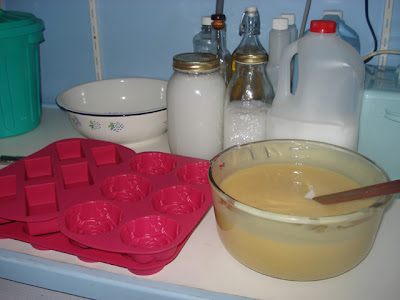
Next Tuesday I'll be starting the first of two workshops on soap making at my local Neighbourhood Centre. The classes are booked out, twice. Last weekend, I decided to make a batch of soap so that those participants on the first day will have a bar of soap to take home with them. I also wanted to go through the procedure and focus on the important parts of the process. I decided to change my recipe. I have found that coconut oil has been harder to come by recently, and it's expensive, so I made this batch using 250 grams/one cup of Copha, which is the solidified coconut oil you can usually buy quite easily at the supermarket. To make up for the reduced amount coconut oil, I added more olive oil, so I got more of a castile-type soap that should be very good for the skin.

Another change was new moulds. I asked Hanno to keep his eyes open for some soap moulds, I rarely go to the shops now, and he came home with some excellent choices. I made four roses, 4 long bars, and 12 small rounds. I stamped all of the bars the following day before they became too hard to impress and I'm very happy with all of them. BTW, these moulds are silicon cake moulds.


Making soap and other general cleaners, will stop you buying all those expensive, harsh chemical cleaners you find in that long stinky aisle in the supermarket. Add that to the bread you bake at home which is cheaper than the expensive bakery-style breads, the yoghurts, ginger beer, jams, sauces, fresh cheese and all those meals cooked from scratch and you're beginning to see real savings at the supermarket whenever you shop. There is no doubt about it, putting the time in a home to make much of what you use will save you money, make you more self reliant, will reduce the number of harsh chemicals, preservatives and colourings you have to deal with, and will enrich your life in the learning and supporting of those old skills.
This is the new recipe I used. Please note, ALL the ingredients were weighed accurately:
- Lye 204 grams
- Rain water 540 mls
- Olive oil 750 mls
- Rice Bran Oil 500 mls
- Copha 250 mls Copha comes in a block that is melted when you heat the oils.
Here is my soap making tutorial. I used the same method to make my soap.
 The various oils used in soap making are chosen for their specific qualities. For instance, olive oil and rice bran oil are used for the creamy soap they make as well as being very good on the skin. Coconut oil hardens the bars of soap as well as giving a good lather. I choose to make a simple soap. I don't like adding colours or fragrance, I like plain, plain, plain. I want soap that is good for my skin and cleans well, if it looks like the good French bars of soap, that's a bonus. However, it is certainly possible to add colour and fragrance to this soap, and you can find out how, here.
The various oils used in soap making are chosen for their specific qualities. For instance, olive oil and rice bran oil are used for the creamy soap they make as well as being very good on the skin. Coconut oil hardens the bars of soap as well as giving a good lather. I choose to make a simple soap. I don't like adding colours or fragrance, I like plain, plain, plain. I want soap that is good for my skin and cleans well, if it looks like the good French bars of soap, that's a bonus. However, it is certainly possible to add colour and fragrance to this soap, and you can find out how, here.I'm looking forward to my soap making classes. They will bring more people closer to self reliance, they will help maintain and add to the knowledge base of traditional soap making and they will help build my community. I already know that some of those people who attend won't have met each other, but through these workshops, they may forge friendships that last a lifetime. Bringing like-minded souls together is a powerful thing. I hope you're making soap and your home supplies of bread, jams, sauces, laundry powder and all those other things that are easily done at home. If not, maybe this soap is a good way of starting.
ADDITION: Annie Jones in the US has sent in the information that is very helpful. Thanks Annie:
"Copha is not readily available here, but I have found a fairly inexpensive coconut oil at many Wal-Mart stores. It's LouAna brand, located in the cooking oil section, in a white plastic cannister with either a brown or a green lid.
It's not organic, but it only costs about $5 or $6 dollars for 31.5 ounces. It's about half the price of what I had been paying for coconut oil at the health food store. I use it for both soap making and for cooking."

